The magazines have a distinctly old-school feel to them. The paper feels like newsprint; I always expect to come away from reading one with ink on the tips of my fingers. The covers feature artwork — a photograph or a simple design — usually sent in by readers.
Free to lesbians worldwide, each cover reads, but the suggested donation is $7/issue (more if you can, less if you can’t).
The issues include notes from subscribers, most of them enthusiastic in their support of the publication.
“I’m a fairly isolated lesbian, young and poor and Southern – a lesbian connection means everything to me,” wrote a subscriber in Tulsa, Oklahoma.
“Please, please keep my LC coming – for me, it’s a lifeline that lets me know that there are still others like me out there,” wrote someone in Lake Barrington, Illinois. “By the way, when I die, whatever’s left after my house sells and the bills are paid will come to LC in thanks for everything you’ve done over the years.”
“I’m so grateful there’s something for lesbians and lesbians only,” wrote a subscriber in Piano di Sorrento, Italy. “When I’m able to donate, I’ll be super glad to do so.”
Lesbian Connection turns 50 in 2024, a remarkable feat for a mostly-print magazine in an era of deep difficulties in the publishing industry, changes in the way the queer community talks to and about itself, and the ubiquity of online discussion spaces. It began in a wildly different time from this one: a time when lesbians routinely lost custody of their children, when teachers could be fired for coming out or being outed, when it wasn’t safe to put the name of their publication on the paper it came mailed in.
This is an audacious story about an audacious group of women, but it’s also a story about the ways queer people have sought one another and found one another across time, and the ways that we figure out how to tell our own stories, despite it all.
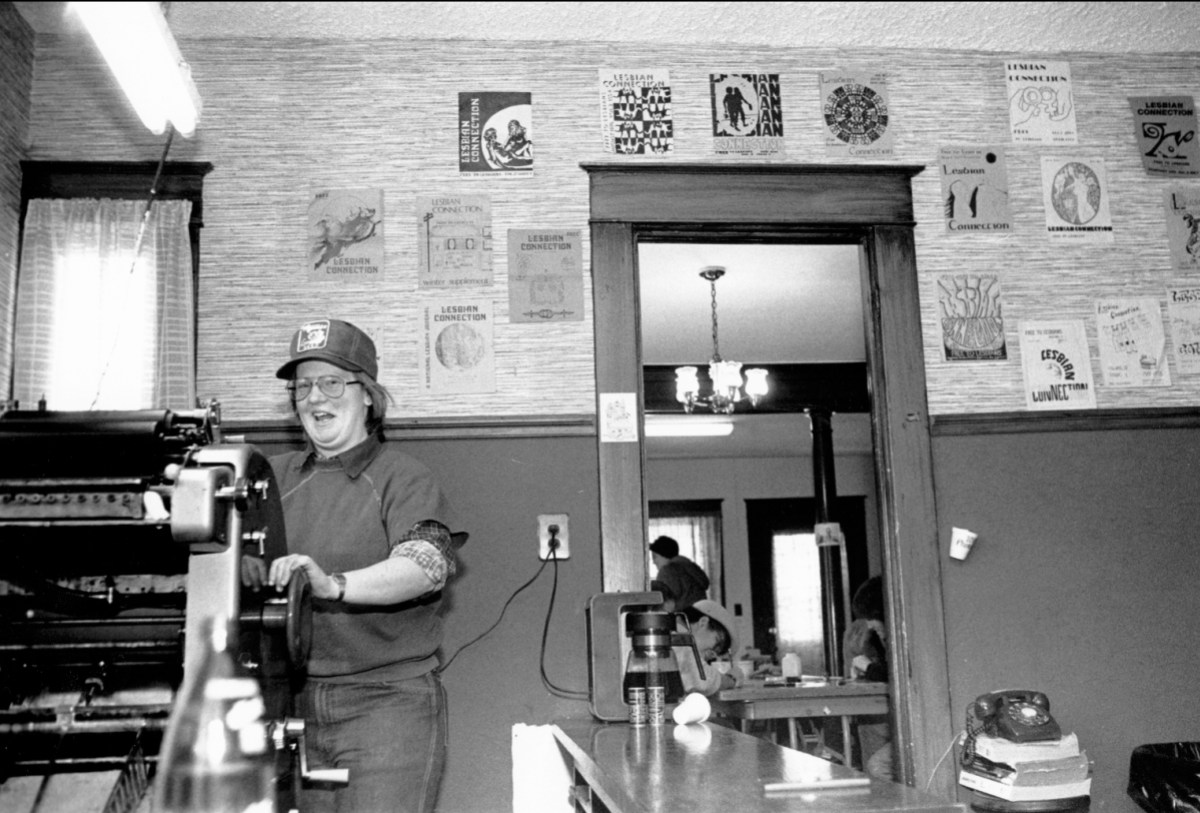
1983 ©JEB (Joan E Biren)
On a September day in 1970, Brandeis University student Susan Saxe firebombed a National Guard Armory in Newburyport, Massachusetts. She stole a truck and ammunition. Later, she donned a red wig and a long purple dress, and along with two men, entered the back door of the State Street Bank and Trust Company in nearby Brighton, brandishing a .30-caliber rifle. The thieves fled in a getaway car with bank bags stuffed with cash. Saxe’s roommate, Katherine Ann Power, was stowed not too far away in a second getaway car to better cover their tracks.
The spree, which included one of their associates killing a Boston police officer, landed Saxe and Power on the FBI’s infamous Ten Most Wanted Fugitives list, two of only 11 women to occupy that position in American history. The pair went on the lam, and stayed that way for years. For at least some part of their shared time as fugitives, Saxe and Power were lovers. They danced at a gay bar called the Warehouse near Hartford, Connecticut; they went to speculum parties together.
The important thing about Saxe and Power is that they weren’t just bank robbers: They were also militants. The money they robbed was to arm the Black Panthers and sabotage military trains. So when the FBI learned that Saxe and Power had been living in a women’s community in Kentucky, the feds began a campaign of intense investigations into feminist and lesbian communities. To be a lesbian, the logic went, was to be a radical.
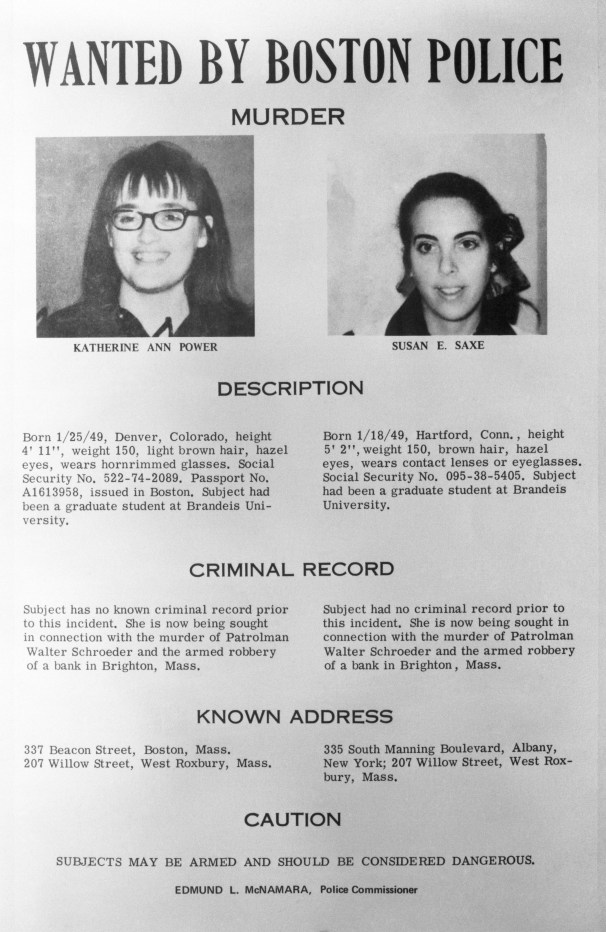
Bettmann via Getty Images
It wasn’t a great time to be asking people to add their names to a list of lesbians. But that’s exactly what Michigan taxi driver Margy Lesher was doing.
Lesher got the idea for Lesbian Connection after taking an epic cross-country road trip with her girlfriend Goldi in a 1969 gold Ford Mustang that barely made it over the Rockies. “A couple of my friends had traveled [a similar route] and they knew people, women, in Atlanta. So that was the first place we stopped,” Lesher told me.
They traveled like that, one place at a time, showing up at the doorsteps of lesbians they only knew through a friend or a friend of a friend.
“Sometimes we would get into town and not know anything or anyone. And one of us would go to the nearest phone booth and try to look up in the phone book any women’s centers or YWCAs or whatever, try to find some woman-oriented thing and call and see if we could find a place to crash.” It was intoxicating to find women like them all over the country, but it was also the seed of an idea. There were lesbian books and lesbian bookstores and lesbian record labels and lesbian musicians all over the country. There was just no good way for lesbians to find out about them.
“If there was no way to get the word out, those things weren’t going to succeed,” she said.
After the six-month road trip, Lesher and Goldi landed back in Michigan along with two kittens, Pip and Squeak, that they’d picked up at a women’s center in Utah. Lesher put the word out, letting everyone know she was starting something new. About a dozen people came to the first meeting.
On the phone with Lesher, now in her 70s, me in Massachusetts and her down in her home in Florida, I pressed for details about that crucial founding meeting. Was there music playing? What were the vibes? Did they have snacks?
Many of those details have been forgotten. The only thing she could say for sure, she said, was that some people were sitting on the floor, because back in those days, her friends had the kind of knees that would tolerate that sort of thing.
Lesbian Connection would mail its introductory letter to about 400 addresses in 1974, with the following explanation of their intentions:
“LESBIAN CONNECTION means communication… we need feedback. … Our purpose is to create a network of communication between lesbians in this country and in Canada; the rest is up to you. We are not yet in sight of a national lesbian community . . . . . but we are on our way.”
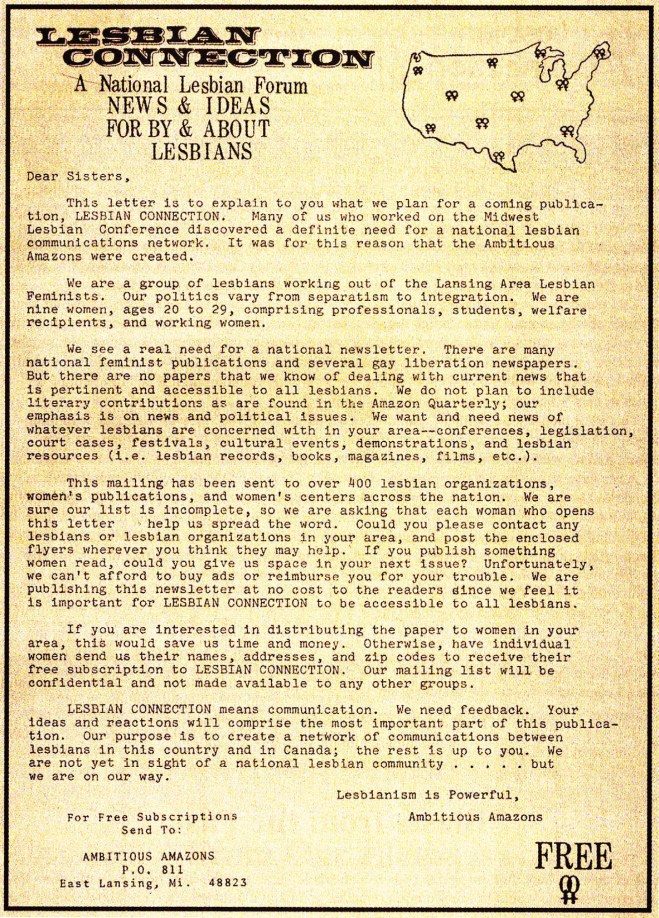
“Did you ever come into contact with anyone that you thought could be an FBI agent?” I asked, following up on the whole Susan Saxe situation.
Lesher thought about it. She hadn’t. But there was a woman named Dena who volunteered with her at the women’s center who said the FBI went to her apartment to talk to her about her activities with lesbian organizations.
Bank robber Katherine Ann Power would remain on the FBI’s Most Wanted list until 1984; she’d remain on the lam until 1993, when she surrendered to the authorities after living for years under the alias Alice Metzinger. Susan Saxe was arrested in Philadelphia in 1975; at her arraignment, Saxe reportedly promised to “fight on in every way as a lesbian, a feminist and an Amazon.”
Lesher and her allies fought on, too. For many years, they’d do it as volunteers, even paying for the privilege of participating. As caretakers of this new thing, they wanted a name for themselves. They called themselves the Ambitious Amazons.
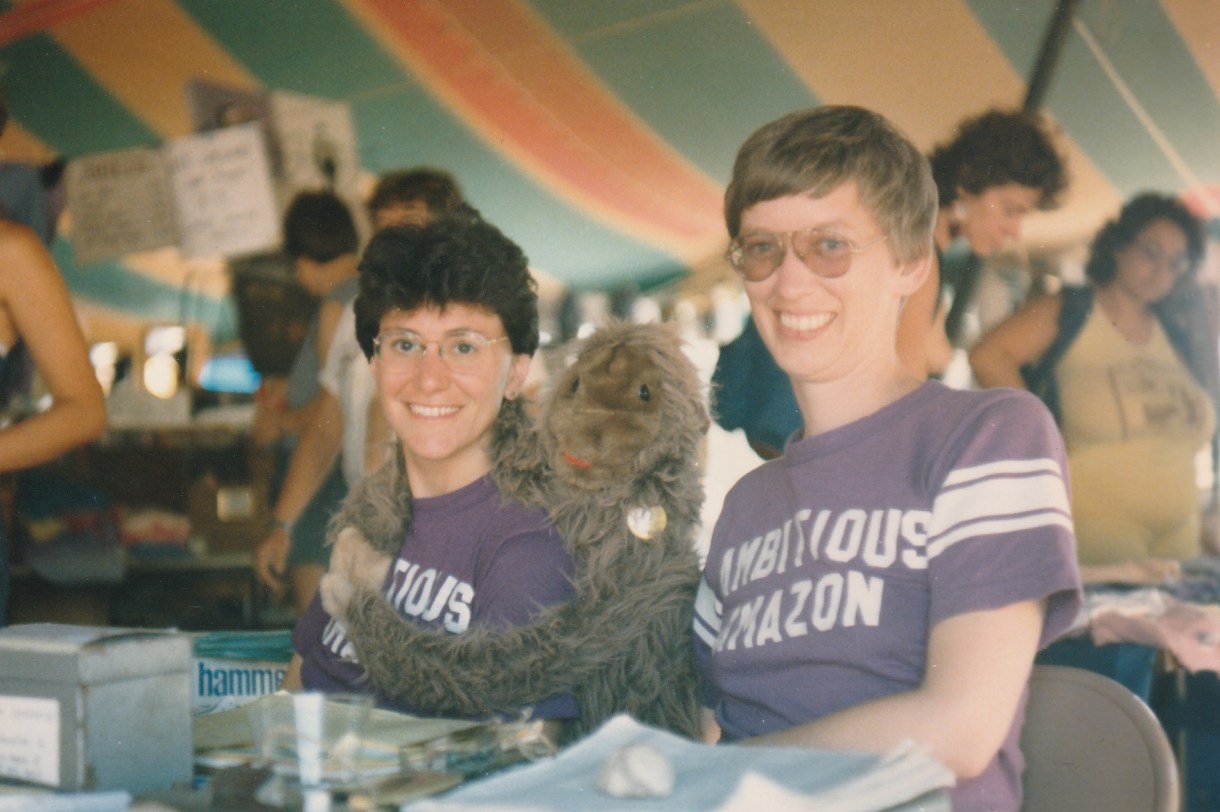
1985
The most notable thing about LC is that it’s a forum: They print letters, articles, book reviews, obituaries, thank-you notes and responses all sent in by their readers.
“My favorite way of describing Lesbian Connection is that it was an online bulletin board before we ever thought of online bulletin boards,” said Julie Enszer, editor of the lesbian literary magazine Sinister Wisdom. “That was one of the revolutionary values of the 1970s: They wanted to hear women’s voices unadulterated by what they saw as a patriarchal system of editing things.”
LC’s editorial stance – that it prints most anything anyone sends in – came from the group of people who curled up on couches and on the floor at that first meeting back in the 1970s. None of them were writers; what would they put in a magazine? They decided from the onset to be a forum for lesbians to get their own words out there.
It may have been revolutionary in the ‘70s, but today it’s a tricky and apolitical stance to take, one that in a strange way puts the Ambitious Amazons in the same position as the Mark Zuckerbergs of the world. How much responsibility should they take for what users submit and what they choose to print?
They got themselves into a bit of a spat recently. The cover of the May/June 2024 edition showcased an image of an old pin that reads, “FEMALE BY BIRTH…LESBIAN BY GRACE AND IF YOU HAPPEN TO SEE GRACE TELL HER I SAY HI.” Some readers canceled their subscription, angered at the transphobia of the message.
In the following issue, Lesbian Connection printed a comment they’d received on Facebook from somebody named Jennifer: “While I understand that some lesbians have strong feelings about trans women and are given a voice inside the magazine, seeing the bigoted phrase ‘Female by Birth’ on the May/June cover really disappointed me. It shows a lack of inclusion of all lesbians, a decision clearly made by the editorial staff, and, thus, representative of LC’s stance. How gross and divisive.”
After Jennifer’s comment, LC published an editor’s note responding to it: “You may be surprised to find out that we do not, as a group, choose what’s on the cover of LC. We don’t all endorse, or sometimes even like, what’s on our covers any more than we agree with everything printed inside.” Somebody had sent the button in as part of a conversation on lesbian visibility; someone on staff remembered it as a joke from back in the day.
Lesher told me something similar over the phone. “Don’t get mad at us and don’t thank us,” she said. “We’re not in charge of what people are saying.”
“If you accept all things that people send in, people are going to send in stuff that is hurtful and painful to people who have additional marginalized identities,” Sinister Wisdom’s Enszer said.
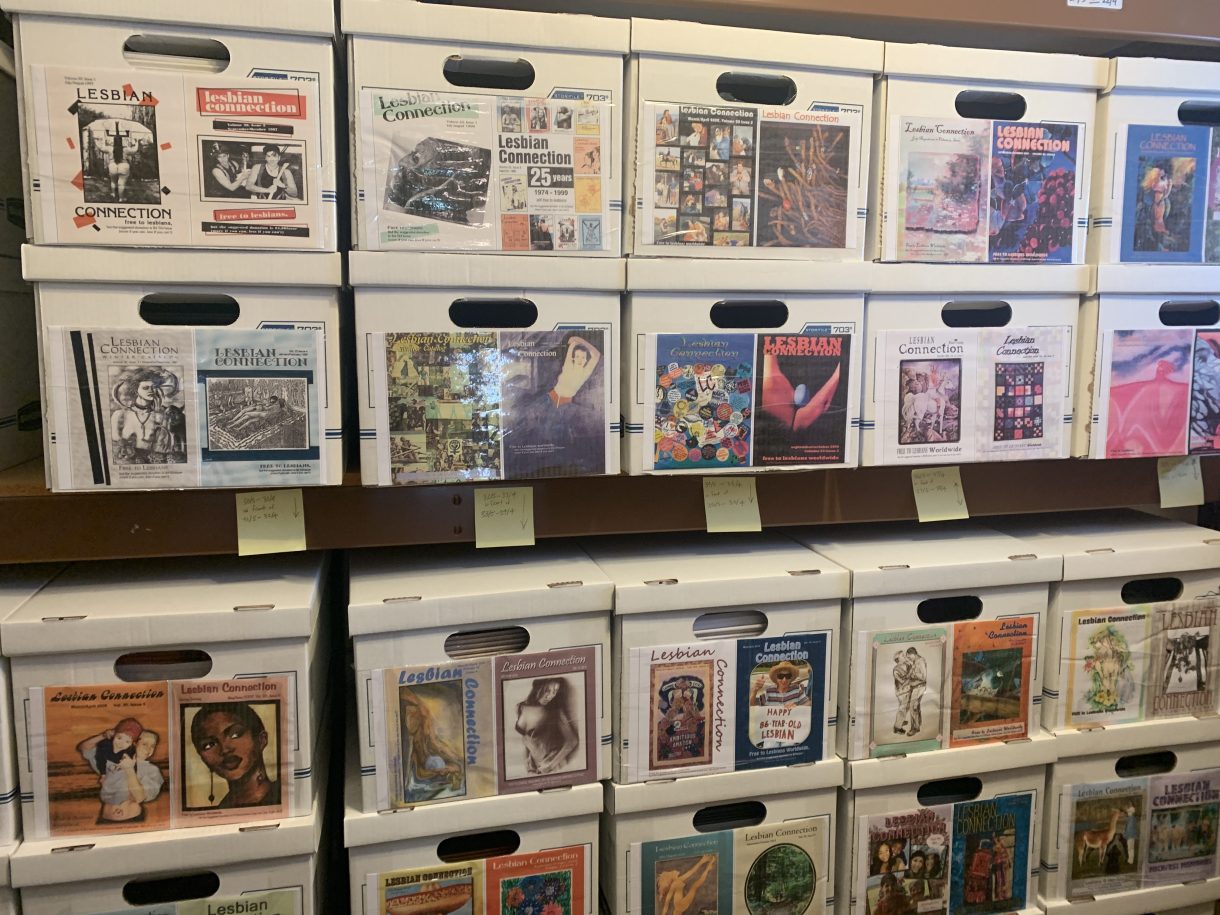
Back issues of ‘Lesbian Connection’ in the archives
The elephant in the room, it seems, is the generational divide. I don’t have age demographics for Lesbian Connection’s subscribers, but judging by the people who write in and what they share about themselves, I think it’s fair to say its core audience is Gen X and Baby Boomers, who grew up in a completely different climate around gender and sexuality. They grew up in an era of womyn-with-a-y, goddess-based spirituality, labrys necklaces, women taking drastic action “to separate themselves from men romantically, historically, and politically,” as Lena Wilson put it in Slate.
“There was gay or straight, and then there were the dreaded bi women, but they just hadn’t decided yet,” subscriber Ann Reppun told me. “Which team do you bat for? Do you sing in our choir? Do you go to our church? Are you a lesbian? Now the continuum has become acceptable.”
Months after the “Female by birth” button was published, a subscriber in Wisconsin followed up. “We are talking about a vintage pin that dates back to around the ‘70s,” they wrote. “I do take offense to labeling our lesbian elders’ pioneering efforts to promote lesbian positivity as ‘gross and divisive’ because you are judging them by our modern language standards.”
Lesbian Connection subscriber Natasha Hope-Johnstone, who is trans, says she doesn’t hold much malice towards what she calls a “transphobia problem” in the magazine. “The flaming bigots I obviously don’t like, and the seemingly lack of an editor to put an end to the endless discussions about trans people seems inviting of bigots,” she said. But, she added, it felt to her like mostly older readers who seemed confused.
Of course, it’s not true that younger queer people are universally more trans-inclusive and older lesbians aren’t: Trans women have always existed in lesbian spaces, and as far back as the 1970s, some cis lesbians fought for their right to be there. But the dominant culture of queer spaces has changed, and plenty of lesbian elders haven’t come along for that ride. Lesbian Connection remains a rare intergenerational queer space where younger lesbians can both learn from their elders and encourage them to do better.
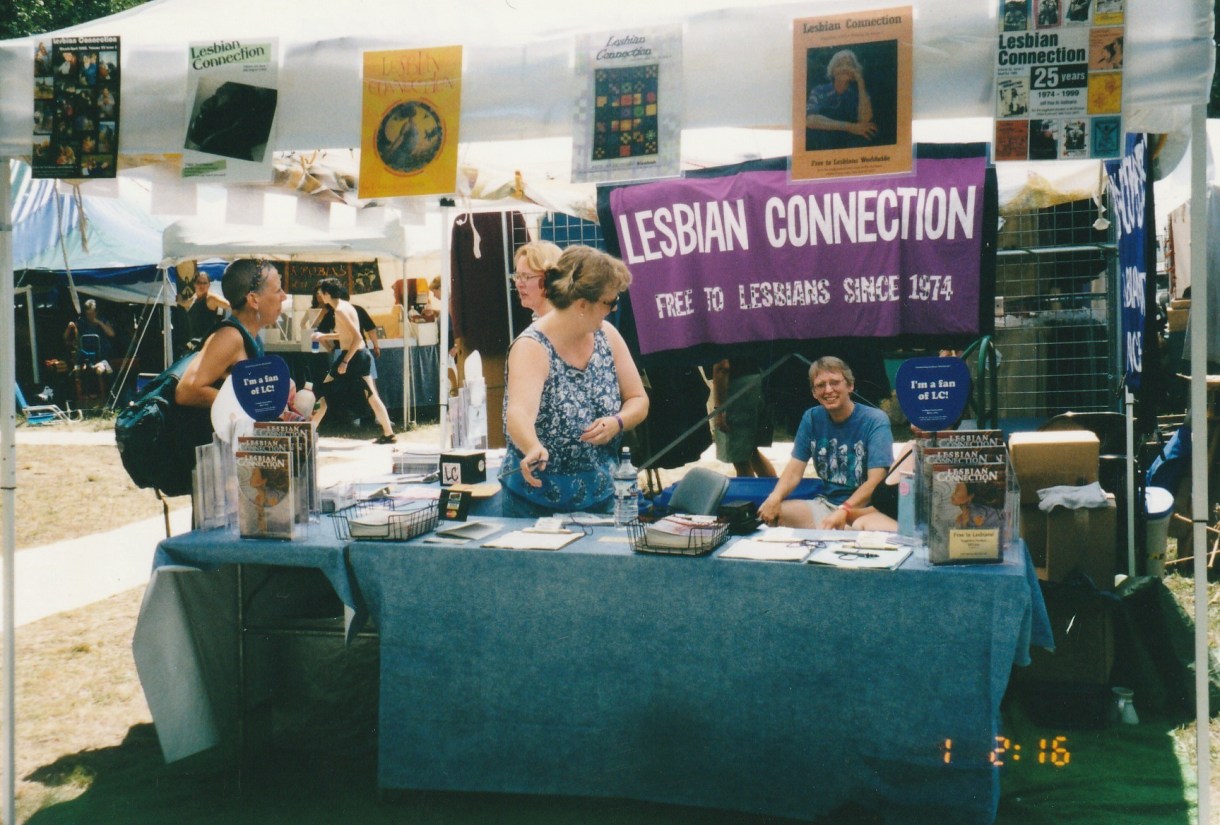
“Lesbian Connection” booth at 2002 Michfest
From the very beginning, the Ambitious Amazons tried to make good on their promise of connecting the lesbian community.
“We are trying to get lesbians in every state (every city?) to be our contacts, to spread the word about this paper as well as to keep us informed of what all is happening in their area,” the Amazons wrote in December, 1974.
People agreed, and they still agree to it today. In 2024, Lesbian Connected published listings for 750 Contact Dykes, including names, email addresses, phone numbers and even sometimes home addresses, in 24 countries and 49 states (all but South Dakota). Any lesbian from anywhere can find safe harbor in Masterton, New Zealand or Jalisco, Mexico or Cooper Landing, Alaska. Not all of the CDs, as they’re called, have volunteered to be hosts, but many of them have. It’s like an informal gay version of CouchSurfing, but it’s more than that. It feels like a clear solution to the problem of Lesher’s road trip, those days of showing up in an unfamiliar city and rifling through a phone book looking for somewhere safe.
They knew that putting your name down on a list of lesbians was a risk, and they tried to make that risk worthwhile. They tried to keep their community safe.
“The FBI has recently questioned some lesbians about their knowledge of women fugitives. Some women who refused to testify before FBI-instigated grand juries are now in jail,” they wrote in May of 1975, around the time of Susan Saxe’s arrest. “We do feel that all of us should be aware of what is happening to lesbians around the country. But as one lesbian pointed out before the Lesbian Cultural Exchange, ‘If even one lesbian does not attend the conference because of fear of FBI investigations, the FBI is winning.’ We cannot begin to fight oppression without being well informed.”
It was the catch-22 of queer publishing: Building a national lesbian community was a risk, but it felt to the Ambitious Amazons like a necessary one. That, at heart, has been the story of queer community-building across time and across cultures, from the Warehouse where Saxe and Power danced the night away to The Stonewall Inn in New York City: We come together however we can, no matter the risk. Finding one another puts us at risk, but it’s only through finding one another that we can keep each other safe.

Board President Kathy Blake and Margy Lesher accepting an award for LC at the 1987 National Women’s Music Festival
To call the early years of Lesbian Connection a shoestring operation is an understatement. In their second issue in December of 1974, in an act of fairly radical financial transparency, LC published their very first budget for the upcoming year. Their total budget was $865.80, or about $5,251 today. They said that up to that point, they’d spent about $95 dollars, including $8.10 for a post office box rental, $12.00 for the printing of flyers, and, quaintly, $3 on miscellaneous office supplies.
They saved some money because volunteers brought reams of paper to donate to the cause. With no typewriter of their own, they snuck into various offices at night to type up what people had sent in.
A lesbian printer in Grand Rapids volunteered to print a few issues, and then the Iowa City Women’s Press printed it for some years. It was about eight or 10 hours each way, cardboard boxes full of magazines weighing down a Toyota station wagon that had been donated by two women from Detroit who called themselves the Red Dykes. They held collating parties; they stapled each magazine by hand.
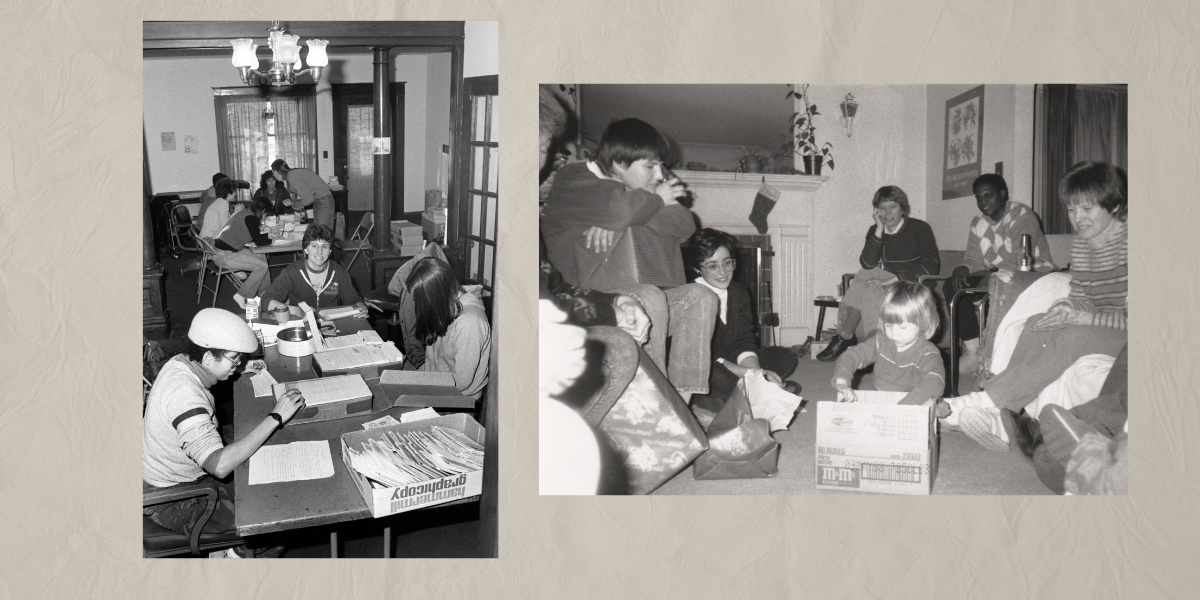
Printing and Collating at the Lesbian Connection Offices // Lesbian Connection Holiday Party
“One of the women who was on the collating crew, she was probably in her seventies, and she got really tired of the stapling,” Lesher said. “So she went out and spent $200 or $300 and bought us an electric stapler.”
Eventually they began to pay a small hourly wage to all staff: $2/hour. In 1994, they bought an old house to use as their office, but until then, the day-to-day work of producing the magazine was done around the dining room table at Lesher’s house, with Amazons taking turns using the computers. (They got their own after advertising a Computer Fund; suggested donation $2.)
Over time, they became more of a traditional employer. They started to offer health care and retirement benefits. But it wasn’t easy.
“Tell me if this is the wrong impression,” I told Lesher on the phone, “But it sounds a little bit like every issue is a victory.”
Lesher agreed. “Every time it goes to the printer, it feels like an accomplishment,” she said.
Sometimes, the Amazons found themselves staring down the end of a fiscal year knowing their income couldn’t cover their expenses. But subscribers came through in the nick of time with donations. As an example, one year there wasn’t going to be enough money for the regular contribution to employees’ retirement funds. They put the word out. A reader sent in a check.
Lisy Harmon, an Ambitious Amazon who has been with the magazine since 2001, said it was that exact kind of contribution that reminded her how much the magazine means to its subscribers.
“This is a place where they can send in their voices to be heard, and find out they’re not alone. There are other women like them,” she said. “They’ve shown many times that they want us to be able to continue to do that.”
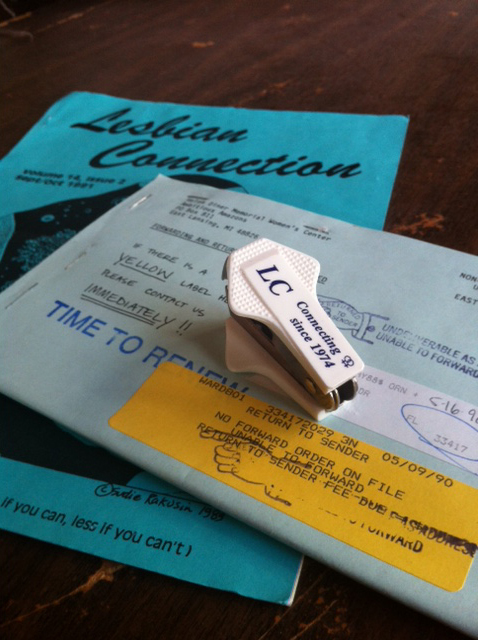
LC’S subscriber numbers are dwindling. They’ve gone down from about 17,000 in 2014 to about 13,000 today. They’re trying to appeal to younger audiences by being more online – there’s a Facebook group, and you can get the publication emailed to you – but judging by the letters from new subscribers, most people are still finding out about it by word of mouth.
For younger subscribers I spoke to, the appeal is less existential and more about curiosity.
“This was my first exposure to people who have changed their name to Moonstar and live on ‘The Land,’ this kind of thing,” said Rebecca Thayer, 30. “It was realizing there was this whole community out there of women’s land, this whole separate area of lesbian spaces that I had not heard of.”
“I’ll be honest that I mostly got a subscription because they include a few pages of Dykes to Watch Out For in each issue, and it was free which for a chronically poor lesbian trying to understand and connect to other lesbians felt like good,” Hope-Johnstone, 30, said. “Though for the first 3 years all I basically did was read the comic parts and skim the rest of the publication.”
Lesbian Connection has outlived countless queer publications. Off our backs; Dyke: A quarterly; Tribad: A Lesbian Separatist Newsjournal. It’s not easy out there for a free queer publication that relies on the generosity of its readers. But in a 2023-2024 fiscal year, Lesbian Connection spent about $602,000 on labor, about $108,000 on printing and postage, and about $28,000 on supplies (a hell of a lot more than that quaint $3 in 1974.) They came away with a total gain of close to $24,000. Their biggest source of income is donations.
Today, Lesbian Connection’s office sits inside an old residential house on a quiet street in Lansing, Michigan. There are two office cats, Izzy and Oliver, the spiritual descendents of the original pair, Pip and Squeak. “They keep the place running,” said Liz Coburn, an Ambitious Amazon. “Any time we feel like we’re taking things a little too seriously, there’s a cat toy that needs to be tossed.”

Office cat on the hunt for a good pic
In 2011, they expanded further, buying another residential house right across the street from their office. That second building houses an archive of Lesbian Connection issues going back 50 years, and the kind of expansive collection of fiction and nonfiction by and for lesbians that a public library could never carry.
“We hear all the time that libraries are being pressured to not have certain books on their shelves,” Coburn said. “We have books that will be available for our community and we just feel like that’s very important.”
It’s also the archival function of the magazine itself that makes it particularly special. LGBTQ+ archives around the country are overflowing with zines and event posters and protest art and the writings of famous queer people, but they can lack the experiences of the vast majority of us who will never donate our papers to a special collection. By publishing the words of everyday lesbians, LC is preserving stories that might otherwise be lost to history.
In the September/October issue, a septuagenarian in Boston described her “out and proud” “working-class dyke collective” getting in people’s faces back in the 60s and 70s. A 70-year-old reader shared her story of growing up as a tomboy in Dublin, Ireland. A 77-year-old organizer from Benson, Arizona wrote about her house being egged, her children being attacked at school, her tires flattened because of her lobbying for change.
Those stories matter, and they deserve to be preserved.
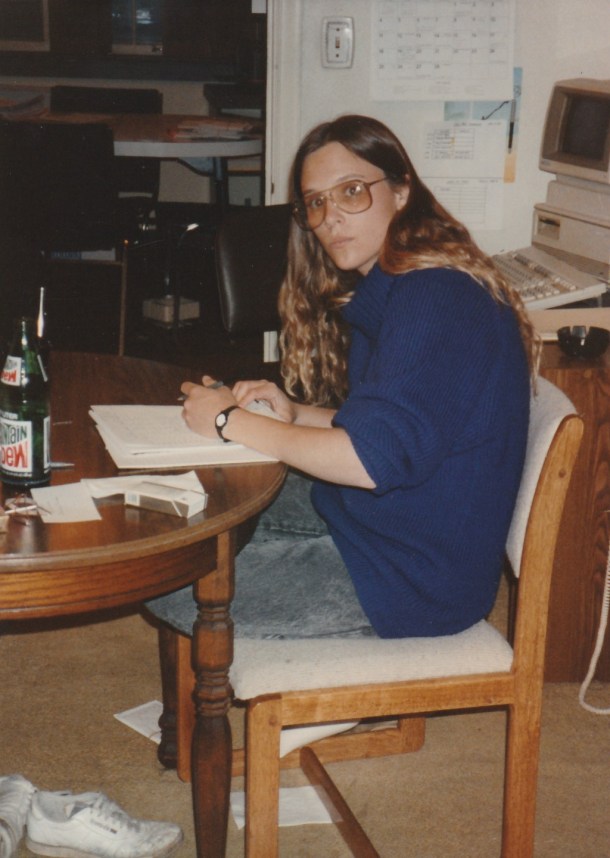
Working on an issue at Margy’s dining room, 1988
It’s hard to say quite why Lesbian Connection has survived when so many other queer publications haven’t. Maybe it’s the physical feeling of rough paper in your hands. Maybe it’s that the responses and the responses to the responses come at two-month intervals, drawing out the dopamine hit of good gossip into a delicious slow burn. But the Amazons would say it’s because they’re a forum. As long as lesbians have things to say, they’ll need a place to say it.
Lesbian Connection was founded in a decidedly pre-internet era, when there were no lesbian characters on TV or in the movies, no lesbian stories on library bookshelves, no out queer pop stars on the radio. Finding another lesbian, another queer person, was always a victory. Today, many younger queer people find one another on TikTok and Tumblr and Lex, on subreddits and Discord servers, at Pride marches and queer clothing swaps and book clubs and WNBA watch parties. But many of us remain isolated in small towns and conservative states, in unaccepting church communities, in jobs where it’s safer to keep quiet, in schools that are removing books about us, in countries that criminalize our love.
The Ambitious Amazons point to those places as their reason for continuing on, the reason that 13,000 people still receive the magazine in its unobtrusive manila envelope every other month. The name of the publication is still not printed anywhere on the outside.
“The bottom line is we are still receiving what women want us to print. Lesbians are still writing in, they are still renewing, they’re still signing up,” Harmon said. “I see it carrying on as long as there’s a need for it.”
Susan Saxe’s note, the one where she vowed to fight on as a lesbian and an Amazon, sounds a whole lot like Harmon. “The love I share with my sisters is a far more formidable weapon than the police state can bring against us,” Saxe wrote. “Keep growing. Keep strong, I am a free woman and I can keep strong, Pass the word. I am unafraid.”



Thanks for linking to my article in News is Out, Sydney. This is a great piece. Back in 2003/2004, I used Lesbian Connection to find a place to stay while I was out in Portland teaching at Rock and Roll Camp for Girls. I was kindly taken in by an older lesbian couple for a few days, who didn’t know me at all. They went to bed at 8pm ha but it was an amazing experience. Always grateful for LC.
I love this! I just happened upon Lesbian Connection and received my first issue last week! I have struggled with feeling disconnected from other lesbians and love that it taps me into that community, especially that it contains perspectives from lesbians in older generations than me. Lesbian centric spaces are so important to help preserve our history, I’m so glad that LC has been doing that work for so long!
Great reporting! Thanks
This was so cool to read, as someone who has been receiving LC for years! The article itself is great but I also LOVED the pictures!
I have been a subscriber of LC for at least 10 years and getting it on the digital version. I might switch back to the hardcopy version so that I have that paper in my hands again because of this article.
I’m make a quarterly donation to LC and love getting the magazines in the mail. It’s a tangible reminder that we have a history much longer than the internet and it provides a much-needed perspective that only our elders can provide. Hearing from lesbians worldwide that are thriving is good for the soul; knowing I can have my own story published is priceless.
Thanks to everyone for commenting! It’s amazing all the support this grassroots lesbian forum has received over the past 50 years.
For LC, –margy
This article was absolutely incredible! It’s wonderful that this has continued for so long – I’m going to tell all my lesbian friends